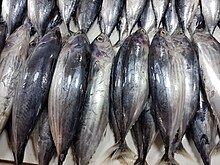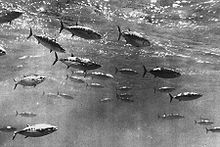Skipjack tuna
| Skipjack tuna | |
|---|---|

| |

| |
| Skipjack tuna in a Philippinesfish market | |
| Scientific classification | |
| Domain: | Eukaryota |
| Kingdom: | Animalia |
| Phylum: | Chordata |
| Class: | Actinopterygii |
| Order: | Scombriformes |
| Family: | Scombridae |
| Subfamily: | Scombrinae |
| Tribe: | Thunnini |
| Genus: | Katsuwonus Kishinouye,1915 |
| Species: | K. pelamis
|
| Binomial name | |
| Katsuwonus pelamis | |
| Synonyms | |
| |
Theskipjack tuna(Katsuwonus pelamis) is aperciformfish in thetunafamily,Scombridae,and is the only member of the genusKatsuwonus.It is also known askatsuo,arctic bonito,mushmouth,oceanic bonito,striped tunaorvictor fish.It grows up to 1 m (3 ft) in length. It is acosmopolitanpelagic fishfound in tropical and warm-temperate waters. It is a very important species for fisheries.[2]
Description
[edit]
It is a streamlined, fast-swimmingpelagic fishcommon in tropical waters throughout the world, where it inhabits surface waters in largeshoals(up to 50,000 fish), feeding on fish,crustaceans,cephalopods,andmollusks.It is an important prey species for sharks and large pelagic fishes and is often used as live bait when fishing formarlin.It has no scales, except on the lateral line and the corselet (a band of large, thick scales forming a circle around the body behind the head). It commonly reachesfork lengthsup to 80 cm (2 ft 7 in) and a mass of 8–10 kg (18–22 lb). Its maximum fork length is 108 cm (3 ft 7 in), and its maximum mass is 34.5 kg (76 lb). Determining the age of skipjack tuna is difficult, and estimates of its potential lifespan range between 8 and 12 years.[2]
Skipjack tuna are batch spawners. Spawning occurs year-round in equatorial waters, but it gets more seasonal further away from the equator. Fork length at first spawning is about 45 cm (18 in). It is also known for its potent smell.[2]
Skipjack tuna has the highest percentage of skeletal muscle devoted to locomotion of all animals, at 68% of the animal's total body mass.[3][4]
Skipjack tuna are highly sensitive to environmental conditions and changes. Climate change effects are significant in marine ecosystems, and ecological factors may change fish distribution and catchability.[5]
Fisheries
[edit]

It is an important commercial andgame fish,usually caught usingpurse seine nets,and is sold fresh, frozen, canned, dried, salted, and smoked. In 2018, landings of 3.2 million tonnes were reported, the third highest of any marine capture fishery (afterPeruvian anchovetaandAlaska pollock).[6] Countries recording large amounts of skipjack catches include theMaldives,France,Spain,Malaysia,Sri Lanka,andIndonesia.[7]
Skipjack is the mostfecundof the main commercial tunas, and its population is considered sustainable against its current consumption.[8][9]Its fishing is still controversial due to the methodology, with rod and reel or fishery options being promoted as ecologically preferable.[10][11][12] Purse seinemethods are considered unsustainable by some authorities due to excessbycatch,although bycatch is said to be much reduced iffish aggregation devicesare not used.[13]These considerations have led to the availability of canned skipjack marked with the fishing method used to catch it.[14]
Skipjack is considered to have "moderate"mercury contamination.As a result, pregnant women are advised against eating large quantities.[15][16][17]In addition, skipjack's livers were tested globally fortributyltin(TBT) contamination. TBT is anorganotincompound introduced into marine ecosystems throughantifouling paintused on shiphullsand has been determined to be very toxic. About 90% of skipjack tested positive for contamination, especially inSoutheast Asia,where regulations of TBT use are less rigorous than in Europe or the US.[18]
As food
[edit]
Japan
[edit]Skipjack tuna is used extensively inJapanese cuisine,where it is known askatsuo(鰹/かつお).It is eaten raw insushiandsashimi,as well as slightly seared inkatsuo tataki.It is also smoked and dried to makekatsuobushi,and the shavings are commonly used to makedashi(soup stock).[19]Katsuobushiflakes are also used as seasoning, such as inonigiri(rice balls) or on top oftofu.The raw viscera of skipjack tuna is salted and fermented to makeshutō,a type ofshiokara.
The fish's fat content changes during migrations along the Japanese islands. When they migrate north in summer, they are calledhasugatsuo( "first katsuo" ) ornoborigatsuo( "ascending katsuo" ), and have a lesser amount of fat. When they migrate south in autumn, they are calledmodorigatsuo( "returning katsuo" ) orkudarigatsuo( "descending katsuo" ), and have a high level of fat.
-
Katsuo no tataki,seared skipjack
-
Assushi
-
Katsuobushiflakes
-
Woman preparing Katsuo,byKeisai Eisen(1790–1848)
Other places
[edit]InIndonesian cuisine,skipjack tuna is known ascakalang.The most popular Indonesian dish made from skipjack tuna iscakalang fufufromMinahasa.It is a cured and smoked skipjack tuna dish, made by cooking the fish after clipping it to a bamboo frame.[20]Skipjack known askalhubilamasin Maldives is integral toMaldivian cuisine.[21]
Skipjack tuna is an important fish in thenative cuisine of Hawaii(where it is known asaku) and throughout the Pacific islands. Hawaiians prefer to eatakueither raw as asashimiorpokeor seared in Japanesetatakistyle.[22]
The trade in pickled skipjack tuna is a driving force behind thecommercial fisheryof this species inSpain.[23]
-
Indonesiancakalang fufu
-
Skipjack drying onMadeira Island
References
[edit]- ^Collette, B.; Acero, A.; Amorim, A.F.; et al. (2011)."Katsuwonus pelamis".The IUCN Red List of Threatened Species.2011:e.T170310A6739812.doi:10.2305/IUCN.UK.2011-2.RLTS.T170310A6739812.en.
- ^abcCollette, Bruce B.; Cornelia E. Nauen (1983).FAO species catalogue. Vol. 2. Scombrids of the world. An annotated and illustrated catalogue of tunas, mackerels, bonitos and other related species known to date(PDF).FAO Fisheries Synopsis. Rome:Food and Agriculture Organization of the United Nations.p. 137.
- ^Calder, William A. (1996).Size, Function, and Life History.Courier Corporation. p. 19.ISBN978-0-486-69191-6.
- ^Bone, Q. (1978).Locomotor muscle.Fish physiology: Academic Press. p. 362.ISBN978-0-08-058527-7.
- ^Yen, Kuo-Wei; Su, Nan-Jay; Teemari, Tooreka; Lee, Min-An; Lu, Hsueh-Jung (2016-12-01)."PREDICTING THE CATCH POTENTIAL OF SKIPJACK TUNA IN THE WESTERN AND CENTRAL PACIFIC OCEAN UNDER DIFFERENT CLIMATE CHANGE SCENARIOS".Journal of Marine Science and Technology.24(6).doi:10.6119/JMST-016-0713-1.ISSN1023-2796.
- ^The State of World Fisheries and Aquaculture 2020.Food and Agriculture Organization. 2022.doi:10.4060/cc0461en.hdl:10535/3776.ISBN978-92-5-136364-5.Archivedfrom the original on 2022-03-04.Retrieved2022-03-08– via fao.org.
- ^Makoto Miyake; Naozumi Miyabe; Hideki Nakano (2004).Historical trends of tuna catches in the world.FAO Fisheries Technical Paper No. 467. Rome:Food and Agriculture Organization of the United Nations.
- ^"FishWatch: Atlantic Skipjack Tuna (Katsuwonus pelamis) ".NOAA.gov.National Oceanic and Atmospheric Administration. November 3, 2009.Retrieved2009-11-12.
- ^"Skipjack tuna, purse seine caught".blueocean.org.Blue Ocean Institute. November 11, 2009. Archived fromthe originalon 2010-06-13.Retrieved2009-11-12.
- ^"BUSINESS: PACIFIC TOLD TO TAKE THE LEAD If region wants to conserve critical resource".Islands Business International. November 2009.Retrieved2009-11-12.
- ^"Pacific tries to show way in sustainable tuna fishing".ABC International - Radio Australia. October 23, 2009.Retrieved2009-11-12.
- ^"Retailers' Guide to Sustainable and Equitable Pole and Line Skipjack".greenpeace.org.Greenpeace International. 27 April 2009.Retrieved2009-11-12.
- ^"Tuna, Skipjack".SeafoodWatch.org.Monterey Bay Aquarium. Archived fromthe originalon 2014-08-19.Retrieved2014-08-16.
- ^Schwartz, Ariel (2012-09-30)."How Safeway Ended Up Selling Cheap, Responsibly-Caught Store Brand Tuna".Fast Company.Retrieved2014-08-16.
- ^"Mercury Levels in Sushi".americanpregnancy.org.Retrieved2013-08-22.
- ^"Mercury Levels in Fish".NRDC.org.Retrieved2013-08-22.
- ^"Advice for Pregnant Women on Fish Consumption concerning Mercury Contamination".mhlw.go.jp.2003-06-03.Retrieved2013-08-22.
- ^Down, Steve."Tuna is attuned to tin".separationsnow.Retrieved2014-04-28.
- ^Naomichi, Ishige (2014).The History and Culture of Japanese Food.Routledge. p. 14.ISBN978-0710306579.
- ^"Cakalang Fufu Jadi Pilihan di Sulut"(in Indonesian). MediaIndonesia. 15 July 2011. Archived fromthe originalon 1 January 2013.Retrieved1 June2012.
- ^Prince, Rose (11 March 2010)."Tuna fishing in the Maldives: the fairest catch".The Telegraph.Retrieved13 April2011.
- ^"Skipjack Tuna (Aku)".Hawaii Seafood.Retrieved2020-01-14.
- ^Pesca y Acuicultura
Sources
[edit]- Pacific skipjack tunaNOAA FishWatch.Retrieved 5 November 2012.
- Western Atlantic skipjack tunaNOAA FishWatch.Retrieved 5 November 2012.
External links
[edit] Media related toKatsuwonus pelamisat Wikimedia Commons
Media related toKatsuwonus pelamisat Wikimedia Commons- Photos ofSkipjack tunaon Sealife Collection












